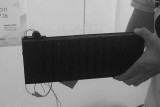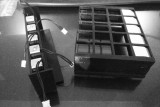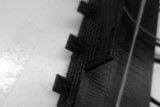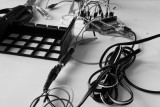
I was always enthused about the combinations of technology and mechanics especially in the fields of the so-called 'Internet of Things'. It almost feels like we as designers are the successors of the engineers of the early industrialization. New production techniques and methods make it even more comfortable to rapidly prototype and create new tangible devices and bring own ideas into the physical world.
This project started with the idea to build my own mechanical solid-state display. A display which does not need electricity in a solid state but can be updated digitally. Therefore in an iterative process I designed modular grid elements which contained multiple small cubes with a white and black side. By turning the white or black side of those little cubes in the grid to the front side a pattern or even text (with a line height of 5 dots) could be displayed. A simple analogue display was created.
The grid parts where designed modularly so that they could be combined to a track of variable length. A small 'train' – controlled by a microcontroller – was engineered to drive along this track to rotate the cubes using just five linear motors (solenoids) controlled by a little web server on a chip (ESP8622) and multiple sensors.
This started as an early project to gain experience in the world of microelectronics and 3D printing. The project additionally involved developing the firmware for the train including a web interface to upload new patterns or texts to be displayed. A custom circuit board was designed to connect and control all the hardware components.
Nevertheless in the end the biggest challenge turned out to be the mechanical part. How do I make the cubes stop their rotation at the exact two intended positions? What's the best way to drive the train without wedging and at an consistent speed? There was just no accurate example for such questions.
I started building this system in one of my last bachelor's classes but as of today I'm still working on it and refining it from time to time.
This project was partly inspired by Berg's Pixel Track case study.
My role in this project
- Technical Concept
- 3D Modelling & -Printing
- Software Development (Java/ESP8266)
- Prototyping
- Iterative Testing
- Presentation







